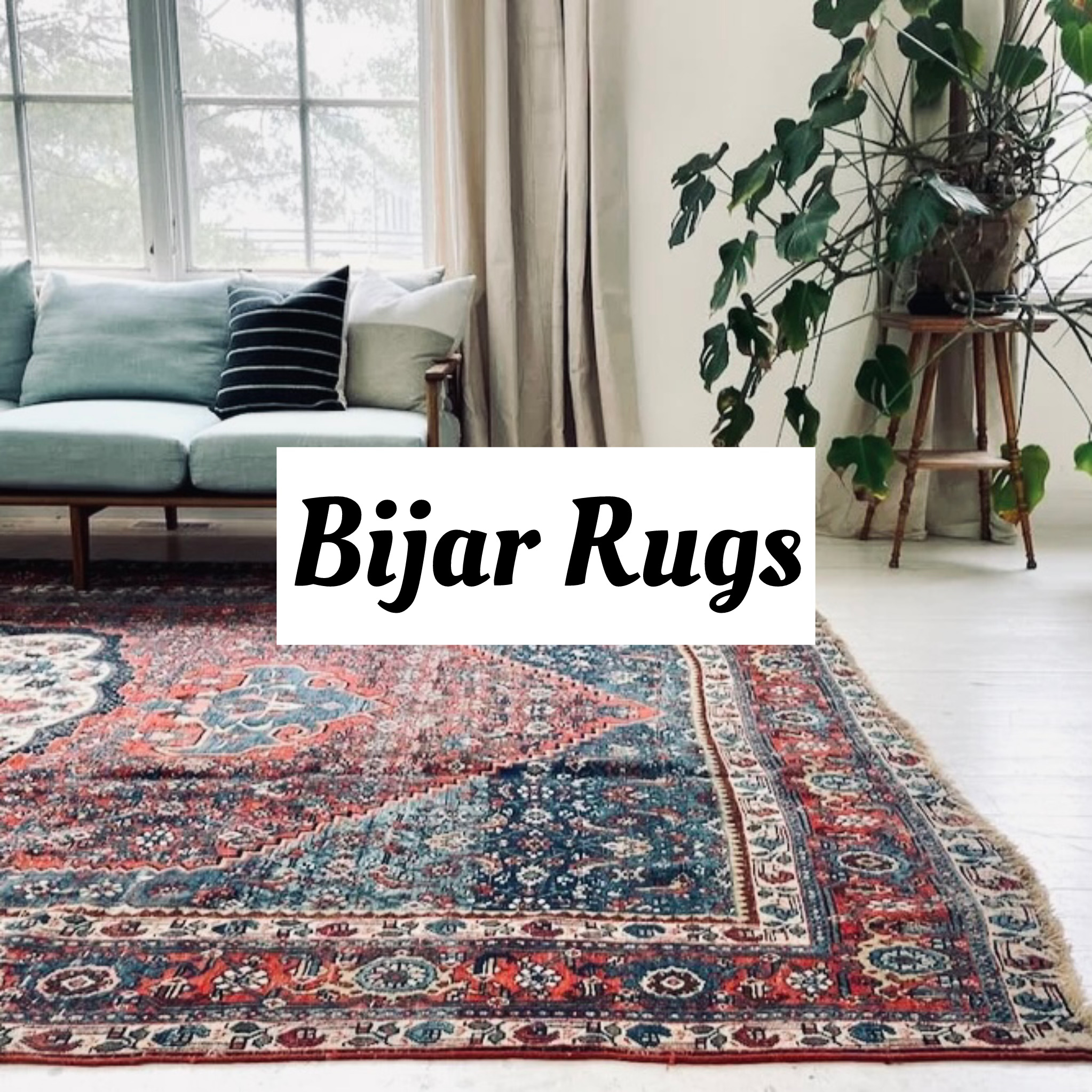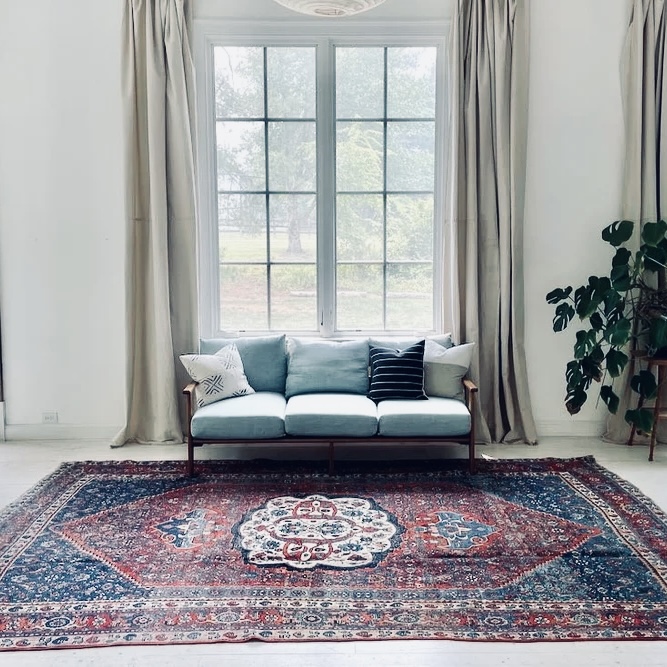Bijar Rugs in Chicago
The Iron Rug of Persia: Why Bijar Rugs Are a Quality Investment
In the vast and storied world of Persian Bijar rugs, one name stands apart for its legendary strength: Bijar. So nicknamed “The Iron Rug of Persia,” a Bijar (also spelled Bidjar) rug is not just a floor covering; it’s an heirloom, a work of art, and one of the most famously durable textiles ever created. For homeowners with a discerning eye, finding the best bijar rug for sale isn’t just a purchase—it’s an investment in a piece of history that will last for generations.
But what gives these rugs their “iron” reputation? And how do you find an authentic, high-quality piece, especially if you’re looking to buy antique bijar rugs for sale?
This guide will walk you through the unique history, incredible construction, and timeless beauty of Bijar rugs, and tell you exactly what to look for when shopping for Bijar rugs in Chicago.

Bijar Traditional Rugs – Fine Craftsmanship
“Bijar rugs, often called the ‘Iron Rugs of Persia,’ are known for their dense weave and enduring beauty — a symbol of strength and art in every knot.”
| Feature | Description | Why It Matters |
|---|---|---|
| Weave & Density | Extremely tight hand-knotted weave | Ensures durability and detailed designs |
| Material | High-quality wool with cotton base | Natural warmth and resilience |
| Color Palette | Deep reds, blues, and earthy tones | Blends with both traditional and modern interiors |
| Pile Height | Low to medium, firm texture | Great for high-traffic areas |
| Care Tips | Vacuum weekly, rotate every 6 months | Maintains even wear and color balance |
What is a Bijar Rug?
A true Bijar rug originates from the city of Bijar and its surrounding villages in the Kurdistan province of Iran. They are woven by Kurdish artisans who have perfected a unique and incredibly laborious weaving technique. This method is the entire secret to their unparalleled density and strength.
While most Persian rugs are known for their suppleness and fine detail, Bijar rugs are known for their unyielding, heavy, and compact body.
The “Iron” Weave: A Feat of Engineering
The “iron” nickname is not an exaggeration; it’s a description of the rug’s construction. Here’s what makes them so different:
- The Turkish (Symmetric) Knot: Bijar weavers use the robust Turkish knot, which is exceptionally strong and well-suited for a heavy-duty rug.
- The “Wet Weave” Technique: This is the key. After a row of knots is tied, the weaver adds not one, but two or three thick, damp wefts (the horizontal threads).
- Heavy Compaction: The weaver then uses a massive, heavy comb-like tool (called a kerkit) to beat these damp wefts and the row of knots down with tremendous force.
This process of wetting the wool wefts and beating them down compresses the knots so tightly that the pile becomes incredibly dense—almost like a solid, plush board. The finished rug is stiff, exceptionally heavy, and its pile is so compacted that dirt and grit cannot penetrate the foundation, making it resistant to wear.
When you hold an antique Bijar rug, its weight and stiffness are the first signs of its quality. This dense pile is also what gives the colors their deep, saturated, and almost jewel-like appearance.
Identifying Bijar Designs: From Village to City
Persian Bijar rugs are not just strong; they are also visually stunning, typically featuring rich, deep color palettes of navy blue, terracotta red, deep brown, and accents of gold and ivory. Their designs can generally be split into two categories:
- Village Bijars: Often more geometric and bold, these pieces feature strong, angular medallions (a classic design is the Garrus or “diamond” medallion) and the iconic Herati (or “fish”) pattern, which is a small, repeating floral motif that resembles a fish.
- City Bijars: These rugs tend to have more curvilinear, floral, and intricate patterns, showcasing a finer weave and a more classical Persian aesthetic.
Whether geometric or floral, the designs are always powerful and well-defined, a perfect match for the robust nature of the rug itself.
The Allure of Antique Bijar Rugs
While modern Bijars are still produced, the most sought-after pieces are the antique Bijar rugs (those 100+ years old) and semi-antique rugs (50-99 years old). Why?
- Unmatched Durability: Because of their construction, these are some of the only antique rugs that can still be found in excellent, usable condition. They were built to withstand generations of use.
- Superior Wool and Dyes: Antique pieces were made with hand-spun, local wool and all-natural vegetable dyes. This results in a patina, or abrash (subtle color variation), that is impossible to replicate with modern synthetic dyes. The colors are richer, softer, and have a depth that only time can create.
- A Sound Investment: When you buy antique Bijar rugs for sale, you are acquiring a piece of textile art that has held—and often increased—its value. They are one-of-a-kind items, and their supply is finite.

Finding the Best Bijar Rugs: What to Look For
When you’re ready to find the best Bijar rug for sale, here’s your checklist:
- Feel the Back: Flip the rug over. The back should feel incredibly dense, firm, and almost “gritty” with the tightly packed knots. It should not be soft and floppy.
- Test the Pile: Press your fingers into the pile. It should be stiff, upright, and very difficult to part and see the foundation.
- Check the Weight: A true Bijar is noticeably heavier than other rugs of the same size.
- Look at the Colors: For antique pieces, look for the subtle, organic variations of natural dyes. The colors should be deep and saturated, not flat or overly bright.
Why You Must See Bijar Rugs in Person
If you’re searching online for “bijar rugs near me,” you’re on the right track. But an antique or high-quality rug is a tactile purchase that should never be made from a photo alone. The weight, the density, and the true colors of natural dyes are all things that must be experienced in person.
This is especially true for Bijar rugs in Chicago. At Rouzati Rugs, we believe in this firsthand experience. Photos can’t convey the “iron” feel or the way light plays off the lustrous, densely packed wool. When you visit our Evanston showroom, you can compare different Bidjar rugs (an alternative, common spelling) side-by-side. You can feel the difference between a village and a city weave, and our experts can walk you through the history and motifs of each specific piece.
We curate our collection to showcase only the most authentic and high-quality antique Bijar rugs, ensuring your investment is a sound one. Stop scrolling through endless online listings and come see and feel the legend of the Iron Rug of Persia for yourself.
A Bijar rug is a statement. It declares a respect for tradition, an appreciation for durability, and a love for timeless art.
Ready to find your “iron rug”? Visit the Rouzati Rugs showroom in Evanston to explore our curated collection of new and antique Persian Bijar rugs today.
FAQ
1. What are Bijar rugs?
Bijar rugs, also known as Bidjar carpets, are hand-woven rugs from the Kurdish city of Bijar in Iran. These rugs are famous for their outstanding longevity, exquisite designs, and one-of-a-kind weaving techniques.
2. What makes Bijar rugs special?
Bijar carpets are well-known for their exceptional durability. Weavers employ a dense knotting technique and high-quality wool to create carpets that can resist heavy foot activity and last for centuries. Furthermore, their elaborate shapes and patterns highlight the Kurdish people’s rich artistic legacy.
3. How can I identify an authentic Bijar rug?
Authentic Bijar carpets frequently exhibit traits that aid in determining their authenticity. Look for tight, dense weaving and a thick pile. Bijar carpets are especially known for their unique patterns, such as the Herati pattern or medallion motifs. Finally, the rug’s weight and sturdiness can suggest its quality and genuineness.
4. What are the typical colors and designs found in Bijar rugs?
Bijar rugs come in various colors, including deep blues, rich reds, brilliant greens, and warm earth tones. The designs vary, but elaborate floral motifs, geometric patterns, and medallion designs that represent ancient Kurdish weaving techniques are common.
5. How do Bijar rugs compare to other types of rugs?
Bijar rugs are well-known for their durability and are frequently regarded as among the world’s toughest rugs. Bijar rugs are distinguished by its tight weave, heavy pile, and resilience to wear as compared to other rug kinds. These features add to their durability and make them an ideal investment for both functional and cosmetic purposes.
6. How should I care for my Bijar rug?
Proper care is essential for preserving the beauty and longevity of your Bijar rug. Regular vacuuming, avoiding direct sunlight, and rotating the rug regularly can all assist in reducing wear and fading. Furthermore, professional cleaning every few years is essential to eliminate deep-seated debris and retain the vibrancy of the carpeting.
Click HERE to watch a video on a Kurdish Bijar rug being professionally cleaned!







